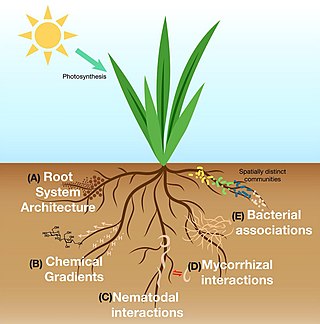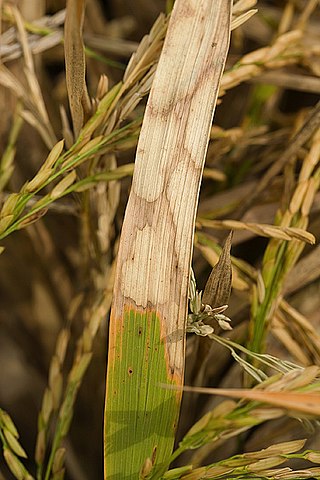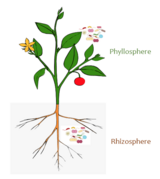
Rhizobia are diazotrophic bacteria that fix nitrogen after becoming established inside the root nodules of legumes (Fabaceae). To express genes for nitrogen fixation, rhizobia require a plant host; they cannot independently fix nitrogen. In general, they are gram negative, motile, non-sporulating rods.

Paenibacillus is a genus of facultative anaerobic, endospore-forming bacteria, originally included within the genus Bacillus and then reclassified as a separate genus in 1993. Bacteria belonging to this genus have been detected in a variety of environments, such as: soil, water, rhizosphere, vegetable matter, forage and insect larvae, as well as clinical samples. The name reflects: Latin paene means almost, so the paenibacilli are literally "almost bacilli". The genus includes P. larvae, which causes American foulbrood in honeybees, P. polymyxa, which is capable of fixing nitrogen, so is used in agriculture and horticulture, the Paenibacillus sp. JDR-2 which is a rich source of chemical agents for biotechnology applications, and pattern-forming strains such as P. vortex and P. dendritiformis discovered in the early 90s, which develop complex colonies with intricate architectures as shown in the pictures:

The rhizosphere is the narrow region of soil or substrate that is directly influenced by root secretions and associated soil microorganisms known as the root microbiome. Soil pores in the rhizosphere can contain many bacteria and other microorganisms that feed on sloughed-off plant cells, termed rhizodeposition, and the proteins and sugars released by roots, termed root exudates. This symbiosis leads to more complex interactions, influencing plant growth and competition for resources. Much of the nutrient cycling and disease suppression by antibiotics required by plants occurs immediately adjacent to roots due to root exudates and metabolic products of symbiotic and pathogenic communities of microorganisms. The rhizosphere also provides space to produce allelochemicals to control neighbours and relatives.
Paenibacillus polymyxa, also known as Bacillus polymyxa, is a Gram-positive bacterium capable of fixing nitrogen. It is found in soil, plant tissues, marine sediments and hot springs. It may have a role in forest ecosystems and potential future applications as a biofertilizer and biocontrol agent in agriculture.
Pseudomonas chlororaphis is a bacterium used as a soil inoculant in agriculture and horticulture. It can act as a biocontrol agent against certain fungal plant pathogens via production of phenazine-type antibiotics. Based on 16S rRNA analysis, similar species have been placed in its group.
Microbial inoculants also known as soil inoculants or bioinoculants are agricultural amendments that use beneficial rhizosphericic or endophytic microbes to promote plant health. Many of the microbes involved form symbiotic relationships with the target crops where both parties benefit (mutualism). While microbial inoculants are applied to improve plant nutrition, they can also be used to promote plant growth by stimulating plant hormone production. Although bacterial and fungal inoculants are common, inoculation with archaea to promote plant growth is being increasingly studied.

A biofertilizer is a substance which contains living micro-organisms which, when applied to seeds, plant surfaces, or soil, colonize the rhizosphere or the interior of the plant and promotes growth by increasing the supply or availability of primary nutrients to the host plant. Biofertilizers add nutrients through the natural processes of nitrogen fixation, solubilizing phosphorus, and stimulating plant growth through the synthesis of growth-promoting substances. The micro-organisms in biofertilizers restore the soil's natural nutrient cycle and build soil organic matter. Through the use of biofertilizers, healthy plants can be grown, while enhancing the sustainability and the health of the soil. Biofertilizers can be expected to reduce the use of synthetic fertilizers and pesticides, but they are not yet able to replace their use. Since they play several roles, a preferred scientific term for such beneficial bacteria is "plant-growth promoting rhizobacteria" (PGPR).
Agricultural microbiology is a branch of microbiology dealing with plant-associated microbes and plant and animal diseases. It also deals with the microbiology of soil fertility, such as microbial degradation of organic matter and soil nutrient transformations.

Phosphate solubilizing bacteria (PSB) are beneficial bacteria capable of solubilizing inorganic phosphorus from insoluble compounds. P-solubilization ability of rhizosphere microorganisms is considered to be one of the most important traits associated with plant phosphate nutrition. It is generally accepted that the mechanism of mineral phosphate solubilization by PSB strains is associated with the release of low molecular weight organic acids, through which their hydroxyl and carboxyl groups chelate the cations [an ion that have positive charge on it.] bound to phosphate, thereby converting it into soluble forms. PSB have been introduced to the Agricultural community as phosphate Biofertilizer. Phosphorus (P) is one of the major essential macronutrients for plants and is applied to soil in the form of phosphate fertilizers. However, a large portion of soluble inorganic phosphate which is applied to the soil as chemical fertilizer is immobilized rapidly and becomes unavailable to plants. Currently, the main purpose in managing soil phosphorus is to optimize crop production and minimize P loss from soils. PSB have attracted the attention of agriculturists as soil inoculums to improve the plant growth and yield. When PSB is used with rock phosphate, it can save about 50% of the crop requirement of phosphatic fertilizer. The use of PSB as inoculants increases P uptake by plants. Simple inoculation of seeds with PSB gives crop yield responses equivalent to 30 kg P2O5 /ha or 50 percent of the need for phosphatic fertilizers. Alternatively, PSB can be applied through fertigation or in hydroponic operations. Many different strains of these bacteria have been identified as PSB, including Pantoea agglomerans (P5), Microbacterium laevaniformans (P7) and Pseudomonas putida (P13) strains are highly efficient insoluble phosphate solubilizers. Recently, researchers at Colorado State University demonstrated that a consortium of four bacteria, synergistically solubilize phosphorus at a much faster rate than any single strain alone. Mahamuni and Patil (2012) isolated four strains of phosphate solubilizing bacteria from sugarcane (VIMP01 and VIMP02) and sugar beet rhizosphere (VIMP03 and VIMP 04). Isolates were strains of Burkholderia named as VIMP01, VIMP02, VIMP03 and VIMP04. VIMP (Vasantdada Sugar Institute Isolate by Mahamuni and Patil) cultures were identified as Burkholderia cenocepacia strain VIMP01 (JQ867371), Burkholderia gladioli strain VIMP02 (JQ811557), Burkholderia gladioli strain VIMP03 (JQ867372) and Burkholderia species strain VIMP04 (JQ867373).

2,4-Diacetylphloroglucinol or Phl is a natural phenol found in several bacteria:
Soil microbiology is the study of microorganisms in soil, their functions, and how they affect soil properties. It is believed that between two and four billion years ago, the first ancient bacteria and microorganisms came about on Earth's oceans. These bacteria could fix nitrogen, in time multiplied, and as a result released oxygen into the atmosphere. This led to more advanced microorganisms, which are important because they affect soil structure and fertility. Soil microorganisms can be classified as bacteria, actinomycetes, fungi, algae and protozoa. Each of these groups has characteristics that define them and their functions in soil.
A bioeffector is a viable microorganism or active natural compound which directly or indirectly affects plant performance (biofertilizer), and thus has the potential to reduce fertilizer and pesticide use in crop production.

The root microbiome is the dynamic community of microorganisms associated with plant roots. Because they are rich in a variety of carbon compounds, plant roots provide unique environments for a diverse assemblage of soil microorganisms, including bacteria, fungi, and archaea. The microbial communities inside the root and in the rhizosphere are distinct from each other, and from the microbial communities of bulk soil, although there is some overlap in species composition.
A phytobiome consists of a plant (phyto) situated in its specific ecological area (biome), including its environment and the associated communities of organisms which inhabit it. These organisms include all macro- and micro-organisms living in, on, or around the plant including bacteria, archaea, fungi, protists, insects, animals, and other plants. The environment includes the soil, air, and climate. Examples of ecological areas are fields, rangelands, forests. Knowledge of the interactions within a phytobiome can be used to create tools for agriculture, crop management, increased health, preservation, productivity, and sustainability of cropping and forest systems.
Induced systemic resistance (ISR) is a resistance mechanism in plants that is activated by infection. Its mode of action does not depend on direct killing or inhibition of the invading pathogen, but rather on increasing physical or chemical barrier of the host plant. Like the Systemic Acquired Resistance (SAR) a plant can develop defenses against an invader such as a pathogen or parasite if an infection takes place. In contrast to SAR which is triggered by the accumulation of salicylic acid, ISR instead relies on signal transduction pathways activated by jasmonate and ethylene.
Markus Weinmann is an agricultural scientist specialising in the area of Plant Physiology at the University of Hohenheim, and ranks as one of the pioneers of Bioeffector-Research aimed at improving plant growth, vitality and disease resistance. He is also coordinator of field experiments in the EU-Biofector-Project.

Mycorrhiza helper bacteria (MHB) are a group of organisms that form symbiotic associations with both ectomycorrhiza and arbuscular mycorrhiza. MHBs are diverse and belong to a wide variety of bacterial phyla including both Gram-negative and Gram-positive bacteria. Some of the most common MHBs observed in studies belong to the phylas Pseudomonas and Streptomyces. MHBs have been seen to have extremely specific interactions with their fungal hosts at times, but this specificity is lost with plants. MHBs enhance mycorrhizal function, growth, nutrient uptake to the fungus and plant, improve soil conductance, aid against certain pathogens, and help promote defense mechanisms. These bacteria are naturally present in the soil, and form these complex interactions with fungi as plant root development starts to take shape. The mechanisms through which these interactions take shape are not well-understood and needs further study.
Disease suppressive soils function to prevent the establishment of pathogens in the rhizosphere of plants. These soils develop through the establishment of beneficial microbes, known as plant growth-promoting rhizobacteria (PGPR) in the rhizosphere of plant roots. These mutualistic microbes function to increase plant health by fighting against harmful soil microbes either directly or indirectly. As beneficial bacteria occupy space around plant roots they outcompete harmful pathogens by releasing pathogenic suppressive metabolites.

Rice-sheath blight is a disease caused by Rhizoctonia solani, a basidiomycete, that causes major limitations on rice production in India and other countries of Asia. It is also a problem in the southern US, where rice is also produced. It can decrease yield up to 50%, and reduce its quality. It causes lesions on the rice plant, and can also cause pre- and post-emergence seedling blight, banded leaf blight, panicle infection and spotted seed.

The plant microbiome, also known as the phytomicrobiome, plays roles in plant health and productivity and has received significant attention in recent years. The microbiome has been defined as "a characteristic microbial community occupying a reasonably well-defined habitat which has distinct physio-chemical properties. The term thus not only refers to the microorganisms involved but also encompasses their theatre of activity".










